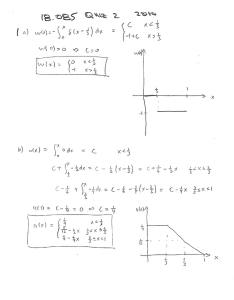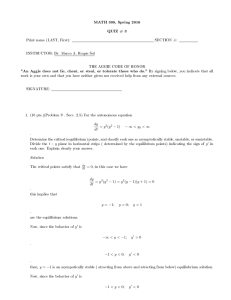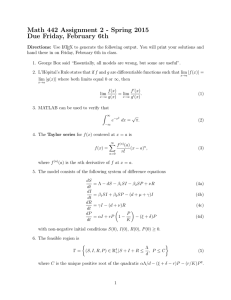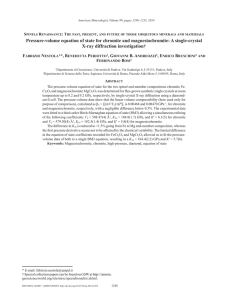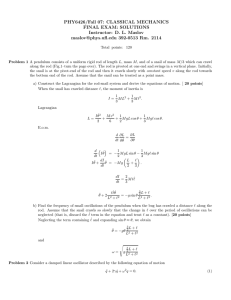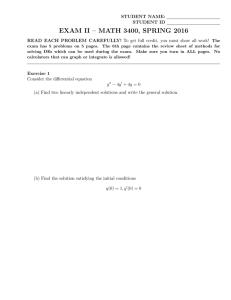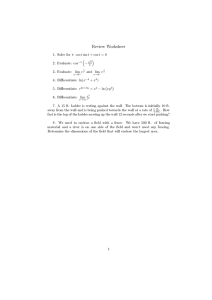Document 10677596
advertisement
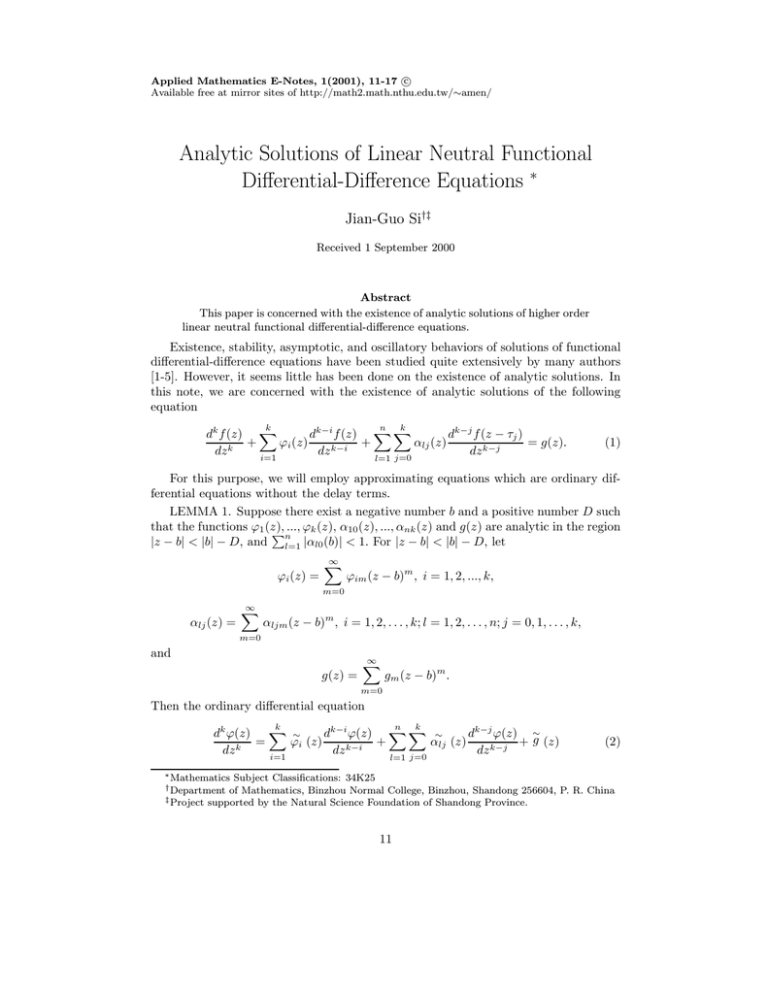
Applied Mathematics E-Notes, 1(2001), 11-17 °c Available free at mirror sites of http://math2.math.nthu.edu.tw/» amen/ Analytic Solutions of Linear Neutral Functional Di®erential-Di®erence Equations ¤ Jian-Guo Siyz Received 1 September 2000 Abstract This paper is concerned with the existence of analytic solutions of higher order linear neutral functional di®erential-di®erence equations. Existence, stability, asymptotic, and oscillatory behaviors of solutions of functional di®erential-di®erence equations have been studied quite extensively by many authors [1-5]. However, it seems little has been done on the existence of analytic solutions. In this note, we are concerned with the existence of analytic solutions of the following equation k n k dk¡ i f (z) X X dk¡ j f (z ¡ ¿j ) dk f (z) X + 'i (z) + ® lj (z) = g(z): k k¡ i dz dz dz k¡ j i=1 j=0 (1) l=1 For this purpose, we will employ approximating equations which are ordinary differential equations without the delay terms. LEMMA 1. Suppose there exist a negative number b and a positive number D such that the functions '1 (z); P :::; 'k (z); ® 10 (z); :::; ® nk (z) and g(z) are analytic in the region jz ¡ bj < jbj ¡ D; and nl=1 j® l0 (b)j < 1: For jz ¡ bj < jbj ¡ D; let 'i (z) = 1 X m=0 ® lj (z) = 1 X m=0 and 'im (z ¡ b)m ; i = 1; 2; :::; k; ® ljm (z ¡ b)m ; i = 1; 2; : : : ; k; l = 1; 2; : : : ; n; j = 0; 1; : : : ; k; g(z) = 1 X m=0 gm (z ¡ b)m : Then the ordinary di®erential equation k n k dk '(z) X » dk¡ i '(z) X X » dk¡ j '(z) » = ' (z) + ® (z) + g (z) i lj dz k dz k¡ i dz k¡ j i=1 j=0 (2) l=1 ¤ Mathematics Subject Classi¯cations: 34K25 of Mathematics, Binzhou Normal College, Binzhou, Shandong 256604, P. R. China z Project supported by the Natural Science Foundation of Shandong Province. y Department 11 12 Di®erential-Di®erence Equation has an analytic solution in the region jz ¡ bj < jbj ¡ D that satis¯es 0 · '(i) (b) < +1; i = 0; 1; : : : ; k ¡ 1; where » 'i (z) = 1 X m=0 » ® lj (z) = 1 X m=0 » g (z) = j'im j(z ¡ b)m ; j® ljm j(z ¡ b)m ; 1 X jgm j(z ¡ b)m : 1 X 'm (z ¡ b)m : m=0 (3) PROOF. We seek a power series solution of equation (2) in the form '(z) = m=0 Substituting (4) into (2) we obtain à ! n X (m + k)! 'm+k 1¡ j® l00 j m! (4) l=1 = k X m X i=1 s=0 + j'is j n k XX (k ¡ i + m ¡ s)! (k ¡ j + m)! 'k¡ i+m¡ s + j® lj0 j 'k¡ j+m (m ¡ s)! m! j=1 n X k X m X l=1 j=0 s=1 l=1 j® ljs j (k ¡ j + m ¡ s)! 'k¡ j+m¡ s + jgm j: (m ¡ s)! By means of the Cauchy inequalities, for any ¯xed r 2 (0; jbj ¡ D); there exists a positive number M such that j'im j · M M M ; j® ljm j · m ; jgm j · m rm r r for i = 1; 2; : : : ; k; j = 0; 1; : : : ; k; l = 1; 2; : : : n; and m = 0; 1; : : : : We now de¯ne a sequence fSm g as follows: for 0 · m · k ¡ 1; Sm = Bm ; and for m ¸ k; Sm = ·X k m¡ Xk (m ¡ i ¡ s)! M (m ¡ k)! Pn S s m¡ i¡ s m!(1 ¡ l=1 j® l00 j) i=1 s=0 (m ¡ k ¡ s)! r +n ¸ k k m¡ X X Xk (m ¡ j ¡ s)! M (m ¡ j)! M M Sm¡ j + n S + m¡ j¡ s (m ¡ k)! (m ¡ k ¡ s)! rs r m¡ k j=1 j=0 s=1 where Bm are arbitrary positive numbers which satisfy j'm j · Bm for 0 · m · k ¡ 1: By induction, we easily see from the de¯nition of Sm that 0 · 'm · Sm for all m ¸ 0: J. G. Si 13 Furthermore, for m ¸ k; by the recursive de¯nition of Sm ; à ! n X 1¡ j® l00 j Sm+1 l=1 = · k m+1¡ k (m + 1 ¡ k)! X X (m + 1 ¡ i ¡ s)! M Sm+1¡ i¡ s (m + 1)! (m + 1 ¡ k ¡ s)! rs i=1 s=0 +n k X (m + 1 ¡ j)! M Sm+1¡ j (m + 1 ¡ k)! j=1 ¸ k m+1¡ X X k (m + 1 ¡ j ¡ s)! M M S + m+1¡ j¡ s (m + 1 ¡ k ¡ s)! rs r m+1¡ k j=0 s=1 (· ¸ (m + 1 ¡ k)! (n + 1)m!M nM m! Sm + (m + 1)! (m + 1 ¡ k)! r(m ¡ k)! +n = +M = k k X X (m + 1 ¡ i)! (m + 1 ¡ j)! Sm+1¡ i + nM Sm+1¡ j (m + 1 ¡ k)! (m + 1 ¡ k)! i=2 j=2 · k m+1¡ k k X 1 X X (m + 1 ¡ i ¡ s)! M M (m ¡ j)! + S + n Sm¡ j m+1¡ i¡ s s¡ 1 r i=1 s=1 (m + 1 ¡ k ¡ s)! r (m ¡ k)! j=1 ¸) k m+1¡ X X k (m + 1 ¡ j ¡ s)! M M +n Sm+1¡ j¡ s + m¡ k (m + 1 ¡ k ¡ s)! r s¡ 1 r j=0 s=2 · ¸ (n + 1)M (m + 1 ¡ k)nM + Sm m+1 (m + 1)r k k X X (m + 1 ¡ i)! (m + 1 ¡ j)! Sm+1¡ i + nM Sm+1¡ j (m + 1)! (m + 1)! i=2 j=2 " # µ ¶ n X (m + 1 ¡ k)! 1 m! + 1¡ j® l00 j Sm (m + 1)! r (m ¡ k)! l=1 à !# " n X (m + 1 ¡ k)nM 1m+1¡ k (n + 1)M + + 1¡ j® l00 j Sm m+1 (m + 1)r r m+1 +M = l=1 k k X X (m + 1 ¡ i)! (m + 1 ¡ j)! +M Sm+1¡ i + nM Sm+1¡ j : (m + 1)! (m + 1)! i=2 j=2 Therefore, we see that Sm+1 Sm = · (n + 1)M (m + 1 ¡ k)nM 1m+1¡ k Pn + + 1¡ m+1 (m + 1)r r m+1 l=1 j® l00 j 1 à 1¡ n X l=1 ! j® l00 j 14 Di®erential-Di®erence Equation ¸ k k X X (m + 1 ¡ i)! Sm+1¡ i (m + 1 ¡ j)! Sm+1¡ j +M : + nM (m + 1)! Sm (m + 1)! Sm i=2 j=2 Letting Cm = Sm+1 =Sm ; we see that Cm = · (n + 1)M (m + 1 ¡ k)nM + j® j m + 1 (m + 1)r l00 l=1 à ! n k X X 1m+1¡ k (m + 1 ¡ i)! 1 + 1¡ j® l00 j + M r m+1 (m + 1)! C C : : : Cm+1¡ i m¡ 1 m¡ 2 i=2 l=1 ¸ k X 1 (m + 1 ¡ j)! ; +nM (m + 1)! Cm¡ 1 Cm¡ 2 : : : Cm+1¡ j j=2 1¡ 1 Pn so that, Cm Therefore, µ ¶¸ n X 1m+1¡ k Pn ¸ 1¡ j® l00 j : m+1 1¡ l=1 j® l00 j r 1 · lim inf Cm ¸ m!1 l=1 1 >0 r and 1 Cm¡ 1 Cm¡ 2 : : : Cm+1¡ i 1 lim inf m!1 Cm¡ 1 Cm¡ 2 : : : Cm+1¡ i 1 lim inf m!1 Cm¡ 1 ¢lim inf m!1 Cm¡ 2 ¢¢¢lim inf m!1 Cm+1¡ i +1; lim sup m!1 = · < for i = 2; 3; : : : ; k: By taking superior limits on both sides of the de¯ning equation for Cm , we now have ( (n + 1)M 1 Pn lim sup lim sup Cm · lim sup m+1 m!1 m!1 1 ¡ m!1 l=1 j® l00 j " à !# · ¸ n X 1m+1¡ k (m + 1 ¡ k)nM + lim sup + lim sup 1¡ j® l00 j (m + 1)r r m+1 m!1 m!1 l=1 ¸ k · X (m + 1 ¡ i)! 1 +M lim sup lim sup (m + 1)! m!1 Cm¡ 1 Cm¡ 2 : : : Cm+1¡ i m!1 i=2 · ¸) k X (m + 1 ¡ j)! 1 1 +nM lim sup lim sup = ; (m + 1)! r m!1 m!1 Cm¡ 1 Cm¡ 2 : : : Cm+1¡ j j=2 J. G. Si 15 that is, lim sup m!1 Thus, we have lim sup m!1 whence ½= Sm+1 1 · : Sm r p m Sm · lim sup m!1 Sm+1 1 · ; Sm r 1 p ¸ r: lim supm!1 m Sm P m This proves that the radius of convergence ½ of the power series 1 m=0 Sm (z ¡ b) satis¯es ½ ¸ r 2 (0; jbj ¡ D): Since r is arbitrary, we see that the power series '(z) is analytic in the region jz ¡ bj < jbj ¡ D. The proof is complete. Next, we let plj = 1 + ¿j b¡ 1 for l = 1; 2; : : : ; n and j = 0; 1; : : : ; k; where b is an arbitrary negative number. Consider the equation k n k dk f (z) X dk¡ i f (z) X X dk¡ j f (plj z ¡ ¿j ) + ' (z) + ® (z) = g(z): i lj dz k dz k¡ i dz k¡ j i=1 j=0 (5) l=1 When b tends to negative in¯nity, this equation tends formally to the given equation (1). For this reason, the equation (5) will be called the approximating equation for equation (1). We now state our main result in this note. THEOREM 1. Suppose equation (1) satis¯es the following hypotheses: (i) for all negative number b which is su± ciently small, there exists a positive number D (independent of b) such that D < jbj ; and the functions '1 (z); : : : ; 'k (z);P® 10 (z); :::; ® nk (z) n and g(z) are analytic in the region jzP ¡ bj < jbj ¡ D; as well as l=1 j® l0 (b)j < 1; 1 m and (ii) the analytic solution '(z) = m=0 'm (z ¡ b) of equation (2) (as asserted in Lemma 1) is bounded in the region jz ¡ bj < jbj ¡ D: Then there exists a number Q < 0 which satis¯es jQj > D and equation (1) has an analytic solution f (z) in the half plane fzj Rez < Qg: PROOF. According to Lemma 1, equation (2) has an analytic solution (4) in the region jz ¡ bj < jbj ¡ D: We assert that the approximating equation (5) has an analytic solution f (zjb) in the region jz ¡ bj < jbj ¡ D which satis¯es jf (i) (bjb)j · '(i) (b); i = 0; 1; : : : ; k ¡ 1: (6) For this purpose we assume f (zjb) has the form f (zjb) = 1 X m=0 fm (z ¡ b)m : Substituting (7) into (5), we obtain the relation µ ¶ n X (m + k)! 1+ ® l00 fm+k m! l=1 (7) 16 Di®erential-Di®erence Equation + k X m n X k X X (k ¡ i + m ¡ s)! (k ¡ j + m)! 'is fk¡ i+m¡ s + ® lj0 fk¡ j+m (m ¡ s)! m! i=1 s=0 j=1 l=1 n X k X m X (k ¡ j + m ¡ s)! ® ljs fk¡ j+m¡ s = gm ; + (m ¡ s)! j=0 s=1 l=1 for m = 0; 1; ::: : By induction, we may then show that jfm j · 'm for all m: Hence, equation (5) has an analytic solution f (zjb) in the region jz ¡ bj < jbj ¡ D that satis¯es (6). In view of condition (ii), we see further that ¯ ¯ ¯ ¯ 1 1 ¯ ¯ ¯X ¯X ¯ ¯ ¯ ¯ 'm (z ¡ b)m ¯ · K fm (z ¡ b)m ¯ · ¯ ¯ ¯ ¯ ¯ ¯ m=0 m=0 in the region jz ¡ bj < jbj ¡ D; that is, the function f (zjb) is bounded in the region jz ¡ bj < jbj ¡ D: Choose Q < 0 and jQj > D. Let B be a bounded region such that its closure is contained in the region fzj Rez < Qg: There is a negative number b0 ; such that fzjjz ¡ bj < jbj ¡ jQjg ¾ B provided b < b0 : Let fbk g1 k=1 be a sequence of negative numbers decreasing to negative in¯nity, with b1 < b0 : The sequence of analytic solutions ff (zjbk )g of equation (5) is a bounded family in B; because of condition (ii). Hence there exists a subsequence fck g of the sequence fbk g; such that the sequence of functions ff (zjck )g converges to a limit function analytic in B; the convergence being uniform in every closed subset of B: By the standard device of expressing the region fzj Rez < Qg as the union of a sequence of such region B; each region including the preceding, the limit function can be continued analytically throughout the region fzj Rez < Qg; so that a function f (z) is obtained, analytic in the region fzj Rez < Qg, and satisfying the relation f (z) = lim f (zjdk ); k!1 where fdk g is some subsequence of fbk g; where it is understood that for each value of z in fzj Rez > Qg the function f (zjdk ) is de¯ned only for su± ciently large values of k; and where the limit is uniform in every closed bounded subset of fzj Rez < Qg: Now f (zjb) is a solution of equation (5). Hence, since the plj appearing in (5) tends to 1 as b ! ¡ 1; it follows that f (z) is a solution of (1). This completes the proof. As an immediate corollary, suppose '1 (z); :::; 'k (z); ® 10 (z); :::; ® nk (z) and g(z) are rational functions, then there exists a positive number D such that D is strictly larger than the absolute values of all the poles of these functions. Thus, the functions 'i (z); ® lj (z) and g(z) are analytic in the region fzj jz ¡ bj < jbj ¡ Dg where Pn b is a negative number which is su± ciently small. If we now assume further that l=1 j® l0 (b)j < 1 and that condition (ii) in Theorem 1 hold, then the conclusion of Theorem 1 will be true. EXAMPLE. Consider the equation f 000 (x) + 1 5x x f 000 (x ¡ ¿1 ) ¡ f 0 (x ¡ ¿2 ) = ; 3 1+x (1 + x) (1 + x)5 (8) J. G. Si 17 where ® 1 (x) = 1=(1 + x); ® 2 (x) = ¡ 5x=(1 + x)3 ; and g(x) = x=(1 + x)5 are analytic in jx¡ bj < jbj¡ 2 for each negative number b which is su± ciently small. The approximating equation of (8) is f 000 (x) + 1 5x x f 000 (p1 x ¡ ¿1 ) ¡ f 0 (p2 x ¡ ¿2 ) = ; 1+x (1 + x)3 (1 + x)5 (9) where p1 = 1 + ¿1 b¡ 1 ; p2 = 1 + ¿2 b¡ 1 : Since the equation '000 (x) = 1 5x x '000 (x) + '0 (x) + 3 1+x (1 + x) (1 + x)5 has a bounded analytic solution '(x) = x=(1 + x) in jx ¡ bj < jbj ¡ 2. By Theorem 1, there exists Q < 0 such that jQj > 2 and equation (8) has an analytic solution in (¡ 1; Q): References [1] J. Hale, Theory of functional di®erential equations, Springer-Verlag, 1997. [2] A. D. Myshkis, Linear Di®erential Equations with Delayed argument, Nauka, Moscow, 1972 [3] E. Pinney, Ordinary Di®erence-Di®erential Equations, University of California Press, Berkeley, Los Angeles, 1958. [4] K. Schmitt, Delay and Functional Equations and Their Applications, Academic Press, New York and London, 1972, 197-217. [5] W. Strodt, Analytic solutions of nonlinear di®erence equations, Annals Math., 44(3)(1943), 375-396.

